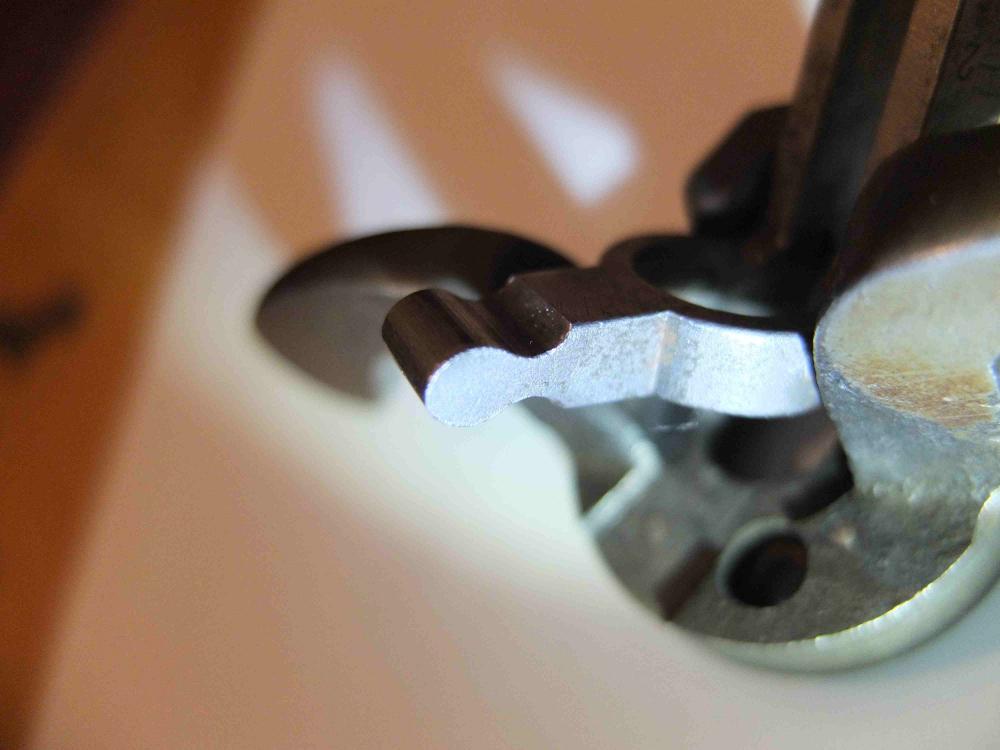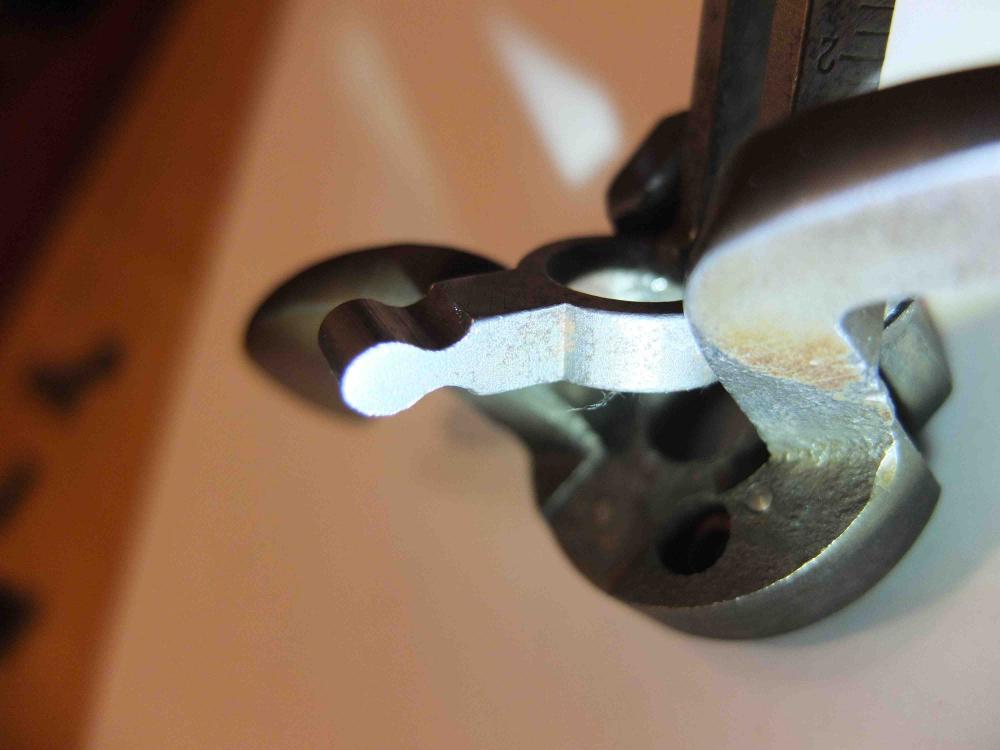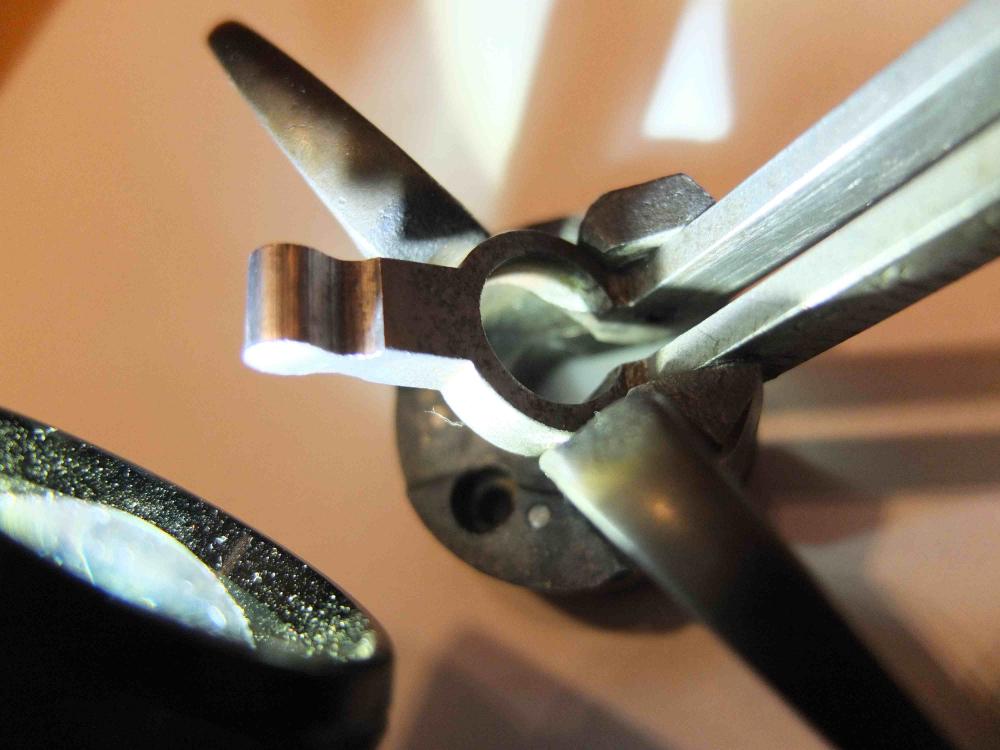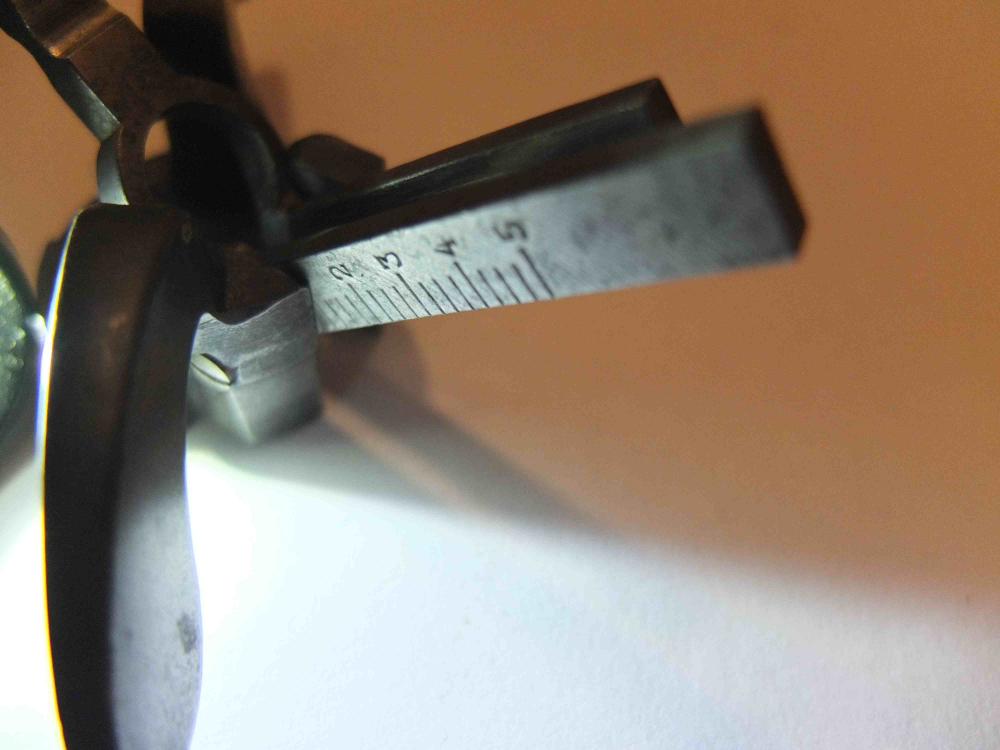-
Posts
108 -
Joined
-
Last visited
Content Type
Profiles
Forums
Events
Blogs
Gallery
Everything posted by Kohlrausch
-

my Pfaff 34 industrial treadle machine
Kohlrausch replied to amateursewing's topic in Leather Sewing Machines
Hi, just a couple of ideas: The Pfaff 34 is a central bobbin machine. The original bobbin cases had a fairly strong spring. Afterkmarket bobbin cases often have a much weaker spring with the additional problem of a wasp waist, which allows the spring to turn sideways, thereby causing an uncontrolled oversized threadopening. Also lint or thread remains may have accumulated under the spring, thereby rendering it unfunctional (remedy: clean it), and the spring may have weakened over time or have been bent. I must admit I have never seen a Pfaff 34 in real life, but my first impression was that the topthread tension might be assembled wrong. The checkspring (red arrow) will be blocked by the post (green arrow). I think, the checkspring should be positioned under the post. The Pfaff 34 is the same generation as my Pfaff 38 (zigzag). My 38 had considerably less pressurefootpressure than my other commercial machines; it was more in line with a good homesewingmachine. My Pfaff 145 has about 40 pounds footpressure, my Adler 5 about 50 pounds, my Singer 29 about 30 pounds and my Pfaff 38 about 10 pounds. You might try to increase the footpressure by adding a second spring. Also on my Pfaff 38 the feeddog mechanism was less efficient than on my other machines, even than the similarly built Pfaff 138. My 38 needed a good teflon foot to transport leather and PVC reliably. I ended up selling my 38. -6 is Pfaff's way to say standard model, it is no specific leather or even saddler's machine. HTH Greets Ralf C. -

my Pfaff 34 industrial treadle machine
Kohlrausch replied to amateursewing's topic in Leather Sewing Machines
Hi, can you please specify exactly what kind of Singer machine you are referring to? There are at least five different Singer 20s: The Singer Serenade 20, the Singer Prima 20, and the Singer Samba 20. Those three are household sewing machines. And then there is the Singer 20 artisan machine as described in this blog: http://keay3.blogspot.de/2012/05/new-to-me-singer-20u-33-sewing-machine.html There would also be a Singer 20 toy sewing machine, but that I don't think you were referring to that ;-) The Pfaff 34 also is an artisan's machine, not a specific leather or even saddler's machine. It can be adaptated to a wide range of uses though, either at the factory as specified by the subclasses, or by the user. What subclass is your Pfaff 34? Have you tried a bigger needle? Please check everything in the threadpath for sharp edges. The Pfaff 34 is about 100 years old. If it has been used in a saddler's workshop it will likely show extensive wear. Threads may have cut deeply into guides causing sharp edges. Maybe shine a light at all the parts and look for bright reflections with a strong loop. I once had a similar problem on a Pfaff 130; polishing threadguides, especially close to the needle, resolved it. Also specifically check and if necessary change the tension disks. About 40 percent of threadwear occur at this place. If you read German you might have a look at Renters, "Der Nähmaschinenfachmann". Here you can find the Renters - Der Nähmaschinenfachmann-books as downloadable scans: http://www.occaphot-ch.com/bernina-startseite/industrie-masch/ Vol. 2 covers Central-Bobbin-machines (Bahngreifermaschinen). The Renters books contain tons of info 'bout repair and adjustment of all kinds of (from todays point of view) older sewing machines. As usual, pictures would make the diagnose a little easier. HTH Greets Ralf C. -
It's like driving a car: Slow down at the bumps. You might even try handwheeling them. (ok, don't try _that_ with the car ;-) There are needleplates with differently sized holes. Usually they have stamped into the underside of the plate. You could look if your plate fits your needlesize. Size 22 is 1.4 mm; you would at least need a needleplate type "B" with 1.8 mm stitchinghole for that. The manual in the link classifies subclass A for needlesizes 10 to 11 und subclass B for needlesizes 12 to 14. It seems your are pushing it a bit, you will probably have to make some adjustments. Nothing wrong with that, upholsterer Cesar Chaflo has put up a couple of tutorials, especially interesting would be tutorial 6: HTH Greets Ralf C.
-

puckers in waxed canvas stitching
Kohlrausch replied to georgeandgracie's topic in Leather Sewing Machines
Hi, a Pfaff 141 would also be needle feed with reverse. Pfaff 142 is the double needle version. Here's the manual https://www.libble.de/pfaff-142/p/743951/ Dunno how often they come up on your side of the Atlantic Ocean. Greets Ralf C. -
Hi, that's easy to explain. Most - by a very large margin - 138 have 4,5 mm zigzag. 4,5 is sufficient for most buttonholes and allows for faster sewing than the wider movement of 6 mm. Very few 138 had 6 mm stitchwidth. These are rather sought after and command higher prices - if buyer and seller notice this detail, that is. The dash 6 on the typeplate has nothing to do with zigzag. For some time -6 was Pfaff's way to say "basic version". About the buttonholes - sorry, I have no idea what I meant ;-) I have just read the words so often that I memorized them - like learning irregular verbs. Greets Ralf C.
-
Hi, I also just had second thoughts. The K-Bobbincase might have worked the other way round. The idea of the K-tensions was to have a very tight needlethread-tension and a rather loose bobbinthread-tension, so that the bobbinthread would be pulled up. This was supposed to look similar to a handstitched buttonhole. I think it is called petit point stitch in English and Perlstich in German. So the K-bobbincase might have a rather loose thread-tension. The aforementioned "Spezial"-bobbincase on the other hand might just have a wider slot to accommodate thicker threads. I think it's general idea is to have the thicker thread in the bobbin because of the shorter threadpath and the possibility to bypass the eye of the needle. If so you might just as well put a file to a standard bobbincase ;-) Greets Ralf C.
-
Hi, that looks like broken off. Probably fell down and somebody stepped on it. Bobbins and bobbin cases have been unaltered by Pfaff for decades, you can easily find spares. Pfaff also markets a bobbin case for thicker thread. http://www.naehwelt-flach.de/Zubehoer/Pfaff-Zubehoer/Zubehoer-Naehen/Pfaff-creative-Spezialspulenkapsel.html This will probably be the equivalent of the K-marked part that has been lost. I have discussed this with my sewingmachine shop and we have not been able to find out the difference between the "spezial"-case and the standard case. You can always turn up the tension on the setscrew of the spring, so I don't quite see the point. On my Pfaff 130 and 138 I have been sewing up to size 138 thread with size 22 needles, which is where the 15x1-needle system (flat shank) maxes out anyway. Over it's period of production the Pfaff 138 has been offered with several needle systems, so flat shank does not necessarily indicate an alteration, it may be the way the machine left the factory. Here's some additional info on threading and a link to the manual: http://www.buzzerco.com/pfaff/ HTH Greets Ralf C.
-
Hi, that's what the machine has two tensions for. Use the left one with the stronger spring for the stronger thread. HTH Greets Ralf C.
-

Feed motion bell crank lever singer 29k adler 30-1
Kohlrausch replied to sandyt's topic in Leather Sewing Machines
Hi, I think it will fit. I have been all over these levers when looking for the cause of ultrashort stitches on my Adler 30-1 and could'nt detect a difference. With my machine it was the drivegear that was worn. I now have a complete Adler-30-head to go in the cellar and a very solid double corrugated cardboard box from Sieck that just arrived today with a speed reducer on my right side. If you want it, you can have it. The head or the lever, that is.The head is used, but seems to work fine - I checked it on my Singer 29. On the other hand - if you order parts from college I'd appreciate it if you could order some for me while youre at it. I am a bit reluctant to order a checkspring for 0,85 and pay 11 Euros for postage ;-) Greets Ralf C. -

Singer 29K S.V. 3 Cobbler Leather Sewing Maschine
Kohlrausch replied to Constabulary's topic in Leather Sewing Machines
Hi, I have it on a 29K1 of 1904. Greets Ralf C.- 18 replies
-
- singer 29k
- 29k3
-
(and 1 more)
Tagged with:
-

Are these machines any good for my materials?
Kohlrausch replied to OnkelMorfar's topic in Leather Sewing Machines
Hi, the Pfaff 138 is easy to work on and uses the same bobbincase as the Pfaff 130, 230, 260, 238, 330, 332, 362 and so on. It should be easy to find, buy or borrow another bobbincase and to test it. As usual, detailed pictures will make it easier to help. Greets Ralf C. -
Hi, the position of the handwheel does not have any influence on the needle size. But the stitching plates usually have two holes of different diameter, and you have to chose the right hole that is suitable to your needle-thread-combination. The needleholder can slide to adjust the distance of eye to hook. With a new shuttle this probably needs adjusting. Adler and Singer needleholders can be interchanged on the patchers, so you might try if you can find a working combination. The needle shoud be inserted with the long groove showing to the left and the small scarf ponting to the hook. This goes for both of your patchers. Greets Ralf C.
-

Singer Model 15-91..............good For Leather Work?
Kohlrausch replied to lb61906's topic in Leather Sewing Machines
Hi, compare your 300 USD Singer 15-91 to this 500 CAD cylinder arm Sunstar machine (km-380bl) http://leatherworker.net/forum/index.php?showtopic=69119&page=3#entry453303 Post 35. 500 CAD equal 385 USD. Greets Ralf C. -

Singer Model 15-91..............good For Leather Work?
Kohlrausch replied to lb61906's topic in Leather Sewing Machines
Hi, first of all I think 300 USD is a bit on the generous side for a Singer 15. These things are about as common as starfish on the beach. Then I'ld stay clear of small sewing machines with integrated motors. You have more choices to drive the machine and and can find replacements more easily with modular setups. Many household sewing machines will do 4 layers of upholstery leather (6 mm), but that's about the limit. It is - amongst other factors - a funtion of the needle length and needlebar stroke. Also thin needles in household sewing machines wil easily bend or break if you try to sew thick layers of leather. Probably the biggest problem: The clampings in household sewing machines aren't strong enough. You might hammer the needlebar up or loose the needle in the leather or a stuck or broken needle may be hit by the hook and throw it off the timing. (Don't ask me how I know ;-) Also pressure foot pressure will be rather low, bu you might work out a way to add a second spring. If you can swing another 10.000 Cents the 1600 USD woud get you a small free arm walking foot with stand, servo motor and speed reducer for added torque, which is a much nicer way to start sewing leather. Greets Ralf C. -
Hi, you couldn't be talked into putting that tutorial online, could you? I always love to learn from the pros. Greets Ralf C.
-
Hi, while I don't have a Pfaff 335, I do have a Pfaff 130. A flatbedmachine using the same hook and bobbins. My Pfaff 130 will happily sew size 138 thread with a size 22 needle. It will sew six layers of 3oz upholstery leather with size 92 thread in an size 18 needle and it will sew 16 layers of 19oz/squareyard truck tarpaulin with size 50 thread and size 18 needles. Same thread top and bottom. It did rip the topthread an a regular basis when exceeding 4 layers of upholstery leather until I searched the machine with magnifying glasses and meticulously sanded off and polished every slight burr in the threadguides. So I guess, technically it's like new or better now. With my motor setup I can't go as slow as is regularly recommended here for leather and when testing for the truck tarpaulin I coud see the thread smoke off when I exceeded the aformementioned limits. My Pfaff 30 would do 20 layers of truck tarpaulin, the 130 not. You should make sure there are no scratches or burrs on any parts that touch the thread, particularly tension disks, needle guides, pressure feet and needle hole in the stitching plate. Polish everything until it shines. Make sure the shank of the needle and the opening in the pressure foot don't touch or you might guillotine your thread. Greets Ralf C.
-
Hi, no and no. The cable delivers electricity to the lamp. The actuator for the footlift would be your finger. The motor is a one trick pony. It spins with 1400 rpm and that's all. If it does anything else it's broken. Sew long Ralf C.
-

Singer 29K72 Patcher (Large Bobbin) Ebay Uk
Kohlrausch replied to Constabulary's topic in Leather Sewing Machines
Hi, my Singer 29K1 presses down with an equivalent of 13 Kilograms (26 pounds). My Pfaff 130 presses down with 4 Kilograms/8 pounds, my Pfaff 30 with 1 Kilogram/2 pounds. My other householdsewing machines also fall into the 1-4kg range. So maybe the Singers's 13 Kilogram can give you some guidance. Greets Ralf C. -
Hi, here http://www.occaphot-ch.com/bernina-startseite/industrie-masch/ you can find a downloadable scan of the German sewingmachine mechanics book "Der Nähmaschinenfachmann". Vol 2 (Band 2) describes the old Pfaff 335, starting at page 108. It's German, but at least there is a drawing of the stitchlength mechanism. HTH Greets Ralf C.
-
Hi, vollstg appears to be short for vollständig meaning complete. And L, (tadaaa, tadaaa, tadaaa!) , is for Leder (Leather). B is for medium heavy stuff. The nomenclature was A, B, C, D - with A being for light material, B for medium material, B/C for medium heavy material, C for heavy material and D for ultra heavy material. Practical differences were diameter of stitchholes, diameter of machine pulley and strength of pressure foot spring. Differences in pressure foot lift would have been H1, H2 (7 mm), H3 (11 mm) and H4 (14 mm). S ( for Stoff (fabric) and L may have been the difference of soft or sharp pressure feet. To the best of my knowledge Pfaff have never openly specified what light or heavy material ment. All of that can have been swapped out or readjusted, of course. Greets Ralf C.
-
Hi, 4 mm (6 spi) was the original maximum stitchlength of this generation of Pfaff walking foot machines. 4,5 mm, 6 mm, 8 mm and 10 mm were different subclasses which would be designated by a letter on the brassplate like M or N. My Pfaff 145 from the same vintage with no extra letter just does 4 mm, after some careful adjustment it does 5 mm. Greets Ralf C. but I can't get any better than 6spi.I'm still trying to figure out how moving the lever changes the spi .
-

Something Wrong, What Do You Think?
Kohlrausch replied to alexitbe's topic in Leather Sewing Machines
Hi, here you can find the Renters - Der Nähmaschinenfachmann-books as downloadable scans: http://www.occaphot-ch.com/bernina-startseite/industrie-masch/ Vol. 2 covers Central-Bobbin-machines (Bahngreifermaschinen) and vol.3 covers the Pfaff zigzags starting with the Pfaff 38 on page 136. The Renters books contain tons of info 'bout repair and adjustment of all kinds of (from todays point of view) older sewing machines. Greets Ralf C. -

Help Identifying An Old Singer Sewing Machine
Kohlrausch replied to FoxJ's topic in Leather Sewing Machines
Pretty speedy stitchers with 3500 spm in 1912. Sure got the leather smoking ;-) Greets Ralf C.- 7 replies
-
- singer
- sewing miachine
-
(and 1 more)
Tagged with:
-
Well, I would admit to about 20 sewing machines, but I have heard, there also are one or two in the London-Camden-Market-area. All of Kilbowie's production at 20 kg/machine would accumulate to about 0,5 percent of one years raw steel production nowadays. At about 120 Euro/ton Kilbowie's entire production would fetch roughly 86,000,000 Euros. I guess, it's worth more if kept alive ;-) Greets Ralf C.






